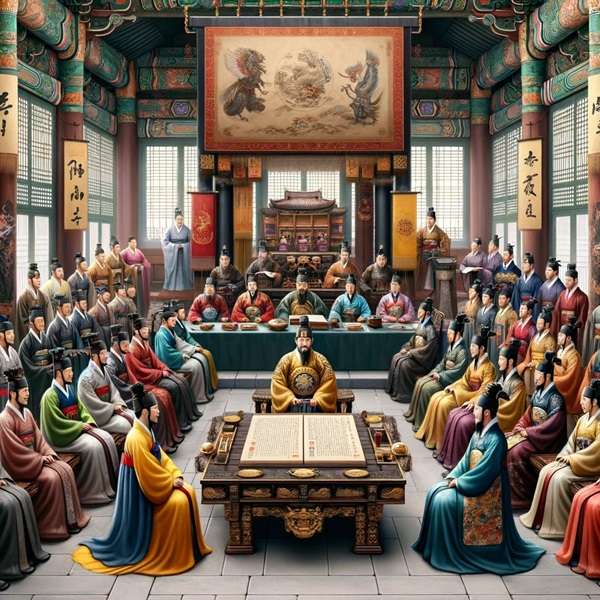
Background Context: The Three Kingdoms of Korea
Before delving into the Silla-Tang Alliance, it’s essential to understand the geopolitical landscape of the Korean Peninsula during this era. The period was characterized by the Three Kingdoms: Silla, Baekje, and Goguryeo. These kingdoms were engaged in frequent conflicts, vying for supremacy over the peninsula.
The Rise of the Tang Dynasty in China
Simultaneously, in China, the Tang Dynasty emerged as a formidable power under Emperor Taizong. Known for its military prowess, cultural richness, and economic strength, the Tang Dynasty was looking to expand its influence over the Korean Peninsula.
The Silla-Tang Alliance: Silla and Tang Against a Common Enemy
The Silla-Tang Alliance was primarily forged to address a mutual concern: the power of Goguryeo. For Silla, Goguryeo’s might posed a direct threat to its quest for dominance in Korea. Meanwhile, the Tang Dynasty, seeking to assert its influence over the peninsula and beyond, saw Goguryeo as a major obstacle.
In 645 AD, Silla, led by Queen Seondeok, and the Tang Dynasty, under Emperor Taizong, formed an alliance. This partnership was a strategic masterstroke, combining Silla’s knowledge of the peninsula’s terrain with the military strength of the Tang.
The Goguryeo-Tang War: A Turning Point
The alliance soon bore fruit in the Goguryeo-Tang War (645-668 AD), a series of military campaigns aimed at subduing Goguryeo. The war was long and arduous, marked by several battles, sieges, and changing fortunes. However, the combined might of Silla and Tang eventually led to the fall of Goguryeo and later, Baekje.
Cultural and Diplomatic Exchanges
Beyond the battlefield, the Silla-Tang Alliance facilitated significant cultural and diplomatic exchanges. The alliance brought about an influx of Chinese culture, technology, and ideas into Silla. Scholars, monks, and artists traveled between the two empires, leading to a blossoming of culture, religion (especially Buddhism), and technology in Silla.
The Aftermath and Legacy
The aftermath of the alliance was complex. Initially, Silla had hoped to gain complete control over the Korean Peninsula with Tang’s help. However, the Tang Dynasty had its ambitions, leading to subsequent conflicts between the former allies. Despite these tensions, the Silla eventually emerged as the unifier of the Korean Peninsula, marking the beginning of the Unified Silla period.
The Silla-Tang Alliance stands as a testament to the intricate dynamics of ancient East Asian geopolitics. It highlights how strategic partnerships can alter the course of history, bringing about significant cultural and political changes. The legacy of this alliance is still evident today in the cultural and historical ties that bind Korea and China, two nations with deep-rooted historical connections.
In conclusion, the Silla-Tang Alliance was more than a mere political arrangement.
It transcended the boundaries of mere political convenience, evolving into a profound conduit for cultural and ideological exchange. This alliance not only reshaped the geopolitical landscape of East Asia but also laid the foundation for a rich tapestry of shared history and mutual influence between Korea and China.
The influence of the Tang Dynasty on Silla was multifaceted. In governance, Silla adopted various Tang administrative and legal systems, refining its own institutions and paving the way for a more centralized and efficient government. Culturally, the impact was even more profound. The influx of Chinese literature, philosophy, and art greatly enriched Silla’s cultural heritage. The adoption and adaptation of Buddhism, in particular, left a lasting imprint on Korean spirituality and art, with many of Silla’s Buddhist temples and artworks inspired by Tang styles yet rendered in a distinctly Korean manner.
The military campaigns and the eventual demise of Goguryeo and Baekje also significantly altered the regional power dynamics. With the fall of these kingdoms, Silla emerged as the dominant power on the Korean Peninsula, albeit briefly challenged by the ambitions of the Tang Dynasty. This period of turmoil and transition was pivotal in shaping the historical trajectory of Korea, leading to the eventual formation of a more unified Korean identity.
However, the alliance was not without its challenges and consequences. The eventual withdrawal of Tang forces from the peninsula and the subsequent resistance against Tang overlordship was a turning point, reflecting Silla’s growing confidence and desire for true sovereignty. This period of conflict and negotiation further exemplified the complexities of Sino-Korean relations, where diplomacy, warfare, and cultural exchange were inextricably linked.
The Silla-Tang Alliance, in retrospect, was a seminal event in the annals of East Asian history. It was a relationship that demonstrated the nuanced interplay of power, culture, and diplomacy in ancient times. Today, as we look back at this alliance, it offers valuable insights into the dynamics of international relations and cultural exchange in a historical context, reminding us of the lasting impact such partnerships can have on the course of history and the shaping of cultural identities.
In essence, the legacy of the Silla-Tang Alliance goes beyond the confines of historical dates and events. It symbolizes a period of profound exchange and transformation, underscoring the enduring nature of cultural and political interactions in shaping the world we know today.
The An Jung-geun Assassination of Ito Hirobumi: A Turning Point in Korean-Japanese Relations
Hi, I’m [jeybee]. As a long-time resident of Seoul, I’m passionate about uncovering the authentic, everyday magic of Korea. This blog is my way of sharing my favorite spots, tips, and cultural insights with you, beyond the usual tourist traps.

